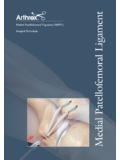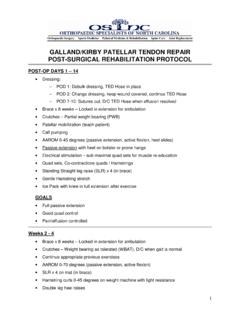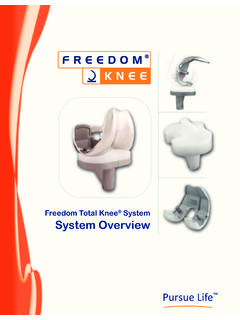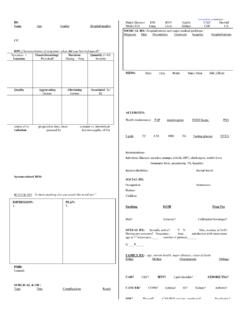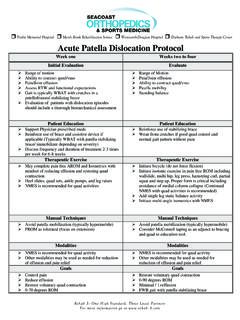Transcription of Rehabilitation Protocol: Patellar Tendon Rupture
1 Laith M. Jazrawi, MD. Associate Professor of Orthopaedics Chief Division of Sports Medicine Tel: (212) 598 6784 Rehabilitation protocol : Patellar Tendon Rupture Name: _____ Date: _____ Diagnosis: _____ Date of Surgery: _____ Phase I: Immobilization and Rehabilitation (4 13 days) Goals o Control pain and inflammation o Maintain Patellar mobility o Maintain hamstring strength of the ipsilateral leg and lower extremity strength of the o contralateral leg o Active knee flexion to 45 and passive knee extension to 0 Intervention: o Crutch training with toe touch weight bearing o Ice and elevation o Isometric ipsilateral hamstring exercise, contralateral LE strengthening o Gentle medial/lateral Patellar mobilization (~25%) o AROM, AAROM and PROM o Hinged knee brace locked in extension Phase II: Immobilization and Rehabilitation (2 4 weeks) Goals o Control pain and inflammation o Begin weight bearing o Maintain Patellar mobility o Active flexion to 90 and passive knee extension to 0 o Maintain ipsilateral hamstring and contralateral LE strength o Begin ipsilateral quadriceps retraining Intervention o Crutch training with partial weight bearing (25 50%) o Ice and elevation o Isometric ipsilateral hamstring exercise, contralateral LE strengthening o Gentle medial/lateral Patellar mobilization (~25%) o AROM, AAROM and PROM o Hinged knee brace locked in extension o Ipsilateral quadriceps sets (NO straight leg raises) Phase III.
2 Immobilization and Rehabilitation (4 6 weeks) Goals o Control pain and inflammation o Progress weight bearing (possibly discontinue crutch use) o Active flexion progressed as tolerated and passive extension to 0o o Maintain Patellar mobility o Maintain ipsilateral hamstring and contralateral LE strength o Continue ipsilateral quadriceps retraining Intervention o Progress to weight bearing as tolerated, may discontinue crutch use if good quadriceps o control is acquired o Gait training Laith M. Jazrawi, MD. Associate Professor of Orthopaedics Chief Division of Sports Medicine Tel: (212) 598 6784 o Ice and elevation o Isometric ipsilateral hamstring exercise, contralateral LE strengthening o Gentle medial/lateral Patellar mobilization (~25%) o AROM, AAROM and PROM o Hinged knee brace locked in extension o Ipsilateral quadriceps sets (NO straight leg raises) Phase IV.
3 Immobilization and Rehabilitation (6 12 weeks) Goals o Control pain and inflammation o Progress to full active ROM o Maintain Patellar mobility o Maintain ipsilateral hamstring and contralateral LE strength o Continue ipsilateral quadriceps retraining Intervention o Weight bearing as tolerated o Gait training o Hinged knee brace locked in extension until good quadriceps control and normal gait are o obtained o Ice and elevation o Isometric ipsilateral hamstring exercise, contralateral LE strengthening o Gentle medial/lateral Patellar mobilization (~50%) o AROM o Ipsilateral quadriceps strengthening (straight leg raises without resistance and stationary cycling at 8 weeks) Phase V: Rehabilitation (12 16 weeks) Goals o Complete weight bearing o Progress ipsilateral quadriceps strength o Begin neuromuscular retraining Intervention o Gait Training o No immobilization o Ipsilateral quadriceps strengthening o Proprioception and balance activities (including single leg support) Phase VI: Rehabilitation (16 24 weeks) Goals o Begin running o Sport/job specific training Intervention o Progress program as listed for Phase IV, with sport or job specific training Phase VII: Rehabilitation (> 6 months) May begin jumping and contact sports when ipsilateral strength is 85 90% of contralateral extremity Laith M.
4 Jazrawi, MD. Associate Professor of Orthopaedics Chief Division of Sports Medicine Tel: (212) 598 6784 Comments: Frequency: _____ times per week Duration: _____ weeks Signature: _____ Date: _____



